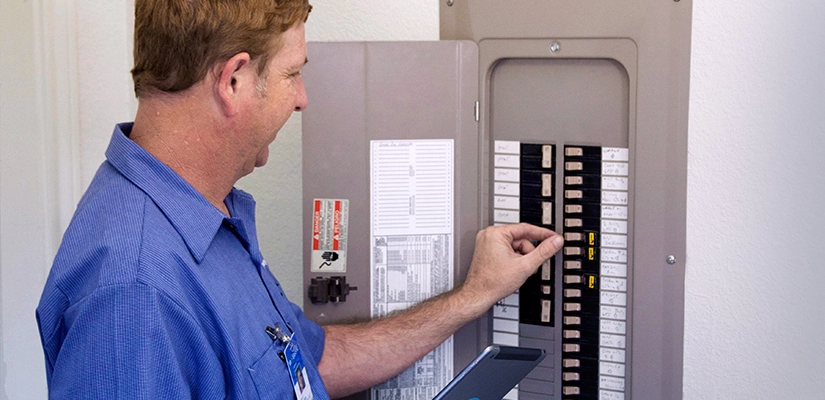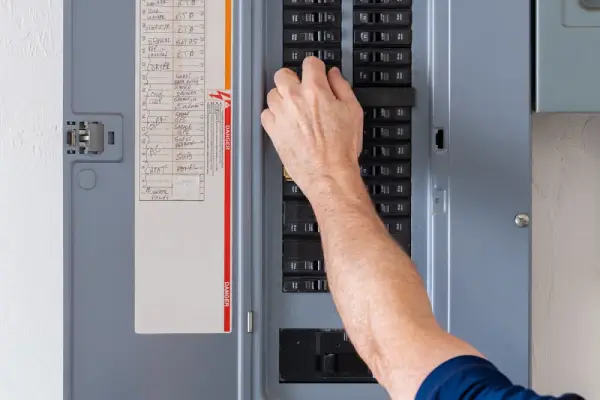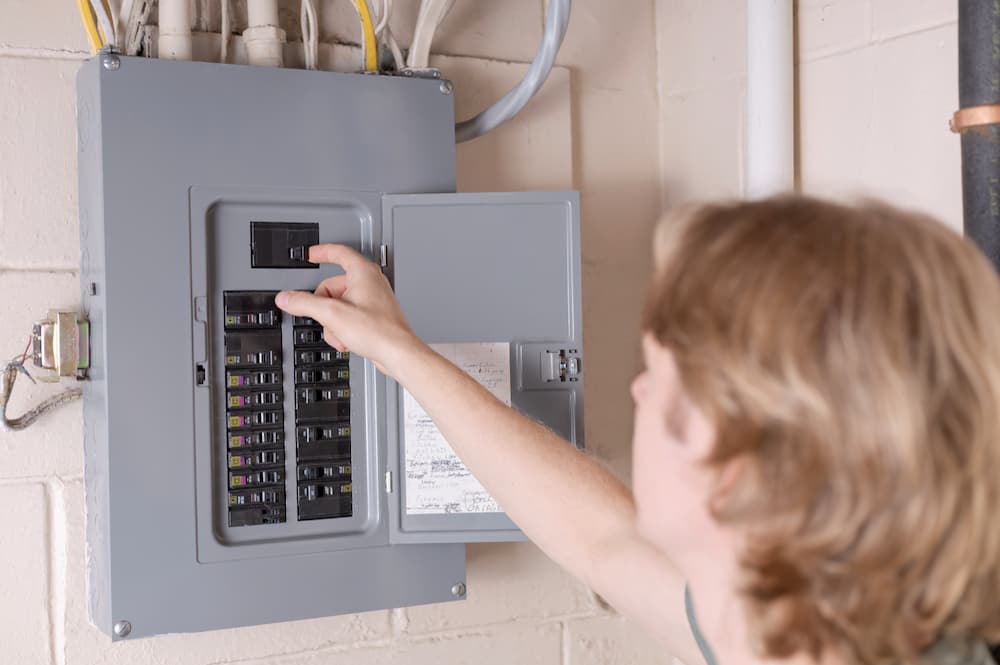
Mr. Electric explains how to safely read your electrical panel to identify circuit breakers and manage home electrical systems.
|
Whether you’ve never looked at your electrical panel or you’re baffled by the equipment inside, you’re not alone. Your breaker panel controls the electrical distribution throughout your home from a single location—and it’s easier to understand than you might expect. This guide will show you how to read a breaker box, reset tripped breakers, and troubleshoot issues that may require professional assistance. Let’s demystify the electrical panel so you can use it when the time is right.
What Is a Breaker Box?

Also known as a breaker panel, circuit breaker panel, or electrical panel, this metal box is the heart of your home’s electrical system. It distributes power to all your outlets, lighting fixtures, and appliances by routing electricity through individual circuit breakers.
Essentially, a breaker panel is a large switchboard. Think of it as the brain of your home’s electrical system.
You’ll usually find the breaker box in a basement, utility room, garage, closet, or outside near your utility meters. The breaker panel itself will be behind a metal door with a safety latch.
What is a circuit breaker?
A circuit breaker is a safety device designed to automatically shut off power if it detects an overload or electrical short. Think of it as the gatekeeper of your home’s wiring. When too much electricity flows through one line—say, if you’re running a hair dryer and microwave on the same circuit—the breaker trips to prevent overheating or fire.
Circuit breakers can also be flipped manually to cut off power from individual circuits, just like a light switch. This function is especially useful when diagnosing outages or installing outlets, switches, and hardwired appliances.
Components of a breaker panel
Before we show you how to read an electrical panel, let’s get familiar with the primary components:
- Main breaker: Typically located at the top or bottom of the panel; acts as the on/off switch for your entire home’s electricity supply.
- Branch circuit breakers: Rows of smaller switches that control specific areas (circuits) or devices.
- Labels or directory: A written list next to the switches identifying each breaker’s zone of control (e.g., “Kitchen Outlets” or “Living Room Lights”).
If your breakers aren’t labeled, jump to our guide on labeling your breaker panel.
How to Read a Breaker Box: Your Electrical Panel Explained

Whether you’re troubleshooting an outage or preparing for a project, understanding how to read a breaker box is easier than you might think. Here’s a step-by-step guide:
Main breaker
The main breaker is the most important switch in your panel. In case of an emergency, you can shut off power to the entire house by flipping the main breaker to the OFF position.
-
Open the panel safely. Open the metal door and keep your hands away from internal wiring. You’ll only interact with the switches.
-
Locate the main breaker. Located at the top or bottom of the panel, the main breaker may have a wider switch or a single switch for two separate breakers.
-
Identify amperage: The amperage should be printed on or near the main breaker. Most homes have a 200-amp main breaker, though smaller homes may have 150 or 100 amps. If the current exceeds this limit, the main breaker will trip to protect your home’s circuits.
The two wires running to the main breaker come from your electric meter. In electricity, everything’s connected!
Branch circuit breakers
Your panel may contain a few different types of breakers, each serving a unique function:
-
Single-pole breakers: The standard breakers for most household devices and appliances. They typically handle 15 or 20 amps and control everything from lighting to garage door openers.
-
Double-pole breakers: Control large appliances such as stoves, dryers, and water heaters. They are usually rated for higher amperage, such as 30 or 40 amps, to handle greater power requirements.
-
AFCI breakers (Arc Fault Circuit Interrupters): Specialized breakers designed to detect arcing due to damaged wires or overheating. AFCIs are required in bedrooms and other areas with high fire risk.
Tripped breakers
If the power is out in a specific area of your home, the most likely reason is a tripped breaker. Resetting a tripped breaker is simple:
-
Review the breaker labels to identify which circuit they control (room, zone, or appliance).
-
If a breaker is tripped, it will sit in the middle position—not fully ON or OFF. Flip it OFF, then ON to reset.
Learn more about what to do if your breaker trips from Mr. Electric® experts.
Pro tip: If the breaker continues to trip after resetting, there could be a deeper issue with the circuit. It’s best to call a professional to avoid further damage or risk.
Empty slots
You might notice some unused slots in your breaker panel. These allow room for future dedicated circuit installations, in case you want to add more electrical appliances or outlets to your home.
Subpanels
Some homes have subpanels that act as smaller versions of the main breaker panel. Subpanels are often installed in addition to the main panel to handle extra power requirements in specific areas of your home, such as an addition or garage.
If your home has a subpanel, it is likely controlled by a high-amperage breaker in the main panel. Typical subpanel breakers are rated for 60, 100, or 200 amps.
Labeling Your Breaker Panel
If someone skipped this step in the past, take the time to test and label each circuit for future reference. Labeled circuits help you identify which switches to turn on and off if a circuit trips, or to shut off a specific breaker for an electrical repair.
The easiest way to label your breaker panel is trial and error:
- Switch off all breakers except one.
- Walk through your house to check for lights and outlets that still work. Bring a small lamp or other electronic device to test outlets quickly.
- Be thorough! One circuit can span multiple rooms.
- Once you’ve determined the room(s) or appliance on the circuit, return to the breaker panel and label the switch.
- Repeat this process with each switch until they’re all labeled.
Pro tip: Label the back of your cover plate with the breaker name for quick circuit identification.
Electrical Panel Safety
While learning how to read a breaker box is useful, safety must always come first. Keep these precautions in mind:
- ALWAYS turn off the main breaker before performing inspections or maintenance on any electrical items in your home.
- Never tape a tripped breaker into the ON position.
- Keep panel access clear—never block it with furniture or boxes.
- Avoid using extension cords in place of permanent wiring.
- Never touch or try to repair exposed wires. If you see any, call a trusted service professional immediately.
- Don’t keep resetting a breaker! If a breaker won’t reset, there may be an overload or other issue. Don’t keep flipping it on; call an electrician for a professional diagnosis.
Understanding how to read a circuit breaker helps you recognize when things go wrong—but fixing them? That’s best left to the pros.
Get Professional Help from Mr. Electric
Learning how to read a circuit breaker or how to read an electrical panel isn’t just helpful—it’s empowering. You don’t need to be an electrician to find your way around your breaker panel, but you should know when to call one for help.
Whether you’re planning a remodel, upgrading appliances, or just want peace of mind, your local Mr. Electric team can help. Our professionals provide electrical panel upgrades and breaker box repairs, along with expert advice and safety inspections, to meet all your electrical needs. Schedule service with a trusted electrician near you today!
This article is intended for general guidance only and is not applicable to every situation. You are responsible for determining the proper course of action for your property and situation. Mr. Electric is not responsible for any damages that occur as a result of advice and/or guidance derived from its blog content.
FAQs About Circuit Breakers and Electrical Panels
The safety of you, your family, and your home is the top priority of every Mr. Electric service professional. Our safety-first commitment to solving your electrical issues includes a meticulous attention to detail on every job. Our commitment also includes using our years of experience to answer your questions. Below are answers to some of the most frequently asked questions about circuit breakers and electrical panels.
What is a breaker box and why is it important?
A breaker box, also known as a breaker panel or electrical panel, is your home’s power distribution center. It houses all your circuit breakers, which prevent overloads and control the flow of power to different areas of your home. Knowing how to read a breaker box can help you troubleshoot outages and protect your appliances.
What is a circuit breaker?
A circuit breaker is a switch that automatically turns off (“trips”) when it detects excess current. This system safeguards against overheating, fire, and damage to appliances. Each breaker is dedicated to a zone or high-use appliance in your home.
Circuit breakers can also be turned off manually to facilitate inspections, troubleshooting, or electrical work.
How do I read a breaker box if it’s not labeled?
To identify unlabeled breakers, start by turning off all breakers except one and noting which lights or appliances remain active. Use two people (one at the panel, one inside the house) and label each breaker clearly. This DIY test helps you understand how to read an electrical panel even when no labels exist.
What’s the difference between a breaker panel and an electrical panel?
There’s no difference—these are interchangeable terms. Both refer to the gray box containing your circuit breakers, sometimes also called a breaker box. Each term describes the same power control center in your home.
When should I call an electrician about my panel?
Call a licensed electrician if you notice:
- A burning smell near your panel
- Frequently tripped breakers
- Buzzing or crackling sounds
- An outdated fuse box
These signs could indicate that your panel is overloaded or unsafe.
Do I need to upgrade my electrical panel?
If your home is older than 30 years or showing signs of strain, your breaker panel may not meet modern electrical demands. Here are some signs it's time for an upgrade:
- Lights flicker when using large appliances.
- Breakers trip frequently.
- The panel is warm to the touch.
- You're installing a major appliance such as a hot tub, EV charger, or new HVAC system.
- Your home has a fuse box instead of breakers.
Still not sure if you need an upgrade? Call Mr. Electric to schedule a professional inspection and assessment.

